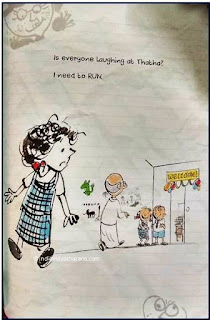Book review of Thatha at School by Richa Jha
There are picture books and there are picture books with surprises. Thatha at School created by Richa Jha and Gautam Benegal and published by Pickle Yolk Books is one such, which directly opens on a special feature for the reader. Very charmingly done, too, referencing the school in the title and leads the reader straight into the story.
The Story
The Art
The lovable story is brought to life by Gautam Benegal’s endearingly rendered characterisation of Thatha, Ovi and her pet dog and their life together. Thatha at School is among the few picture books that actually uses backdrop as part of the illustrations. So, depending on what you wish it to be, you can see images even in the simulated crumpled paper folds that form the backdrop. To me, they seemed to mirror birds in flight much like the young protagonist’s overwrought imagination.
The illustrations by Gautam Benegal are accompanied by Iha Jha’s pencil doodles, which are used not merely to buttress the main text, but function like an aside in themselves. The random drawings, homework, letters, squiggles, games and how-to notes offer a peek into the life and timepass of Ovi whilst also offering cheeky commentary at times. Ovi’s dog also adds to the levity, in one instance, balancing on the pillows under which Ovi is trying to burrow herself to avoid the endless night.
Thus, the main text and colour images, Ovi’s scribbles and the backdrop
create three layers to be seen and read together but they never clash nor
become OTT nor distract the reader from the main story. Hats off to book
designer Abhishek Jha for making all the elements of text and illustrations
cohere so well! It’s a remarkable feat to pull the reader’s attention in
variegated directions without the entire story going off-tangent. There’s also
humour in the juxtaposition. For instance, when Ovi is musing on how Grandparents
Day is a bad idea, the main images and text are accompanied by pencil sketches
of homework and Maths tables!
The artwork and design also match each stage of the story. The passing hours weighing down on Ovi is shown in the placement of her lone figure at the corner of a blank page without doodles. Her growing anxiety is reflected in the squiggle of her stormy mind becoming larger and larger. When Ovi and her Thatha re-unite, the doodles return giving an additional emotional heft to the scenes, especially where they hint at her absent parents. In keeping with Ovi’s journey of her mind, her pencilled doodles have an entire page devoted to them at the end unlike their guest appearance earlier and also reflect her new positivity.
The design is
also thoughtful. For instance, the centre folding obscures the sketch of one of
the grandfathers in the double spread featuring grandparents. But, the same
image is repeated in Ovi’s scrap book, albeit in black and white showing
everything more clearly. Some of the communities who could not be represented
in the double spread make their way to the back cover. Although one does wonder
if this is also some kind of hidden political comment in terms of which
communities make it to the double spread and which get relegated to the back
cover!
Beyond the Story
Ovi's reluctance
to be seen with her Thatha in his dhoti points to the deeper associations we
make about people not being suitable to be presented in certain surroundings if
they’re not dressed in a certain way. It also makes one think about how we
associate celebration and culture with traditional costume. More so, since an
advertisement had a film hero being dismissive of what he dubbed as 'office
wear' instead of 'traditional' attire at a wedding. Here, too, Thatha is shown
wearing colourful pant and shirt in the house and also his dhoti. Yet, when he
dresses up for Grandparents Day, it’s the latter he chooses although there is
no dress code laid down in the invite. The other grandparents also feature in
their traditional costumes.
While on the
face of it, Thatha at School is about
the bond between Ovi and her grandfather, there is a sub-text that can be
gleaned about Ovi herself. She feels weighed down by what people will think and
constantly compares herself with her peers. For instance, this line is telling,
‘I don’t like it when she is happy and I am not.’ Even when she presents her
grandfather, she feels compelled to describe him as the best. The only two pages
without Ovi - besides the single page with her dog’s pyrotechnics – also hint
at her problems with sleeplessness. One page contains an image of a sleeping
mask and the other page, a nightmare scenario of what could happen to stop her
having to go to school. Both underline her anxiety. Besides the absence of her
parents as a likely cause, it makes one wonder whether Ovi imagining a boy
tugging her Thatha’s dhoti or her friends laughing at him indicate some level
of taunting she does face in school. When Ovi finally reconciles to her
Grandfather’s attire, it’s a pity that it stems more from her external
environment rather than internal growth.
Homework for the Reader
Thatha has been
depicted with three horizontal white marks on his forehead. The need to show the
forehead mark at all is not clear given that two of the black and white sketches
of Thatha do not have it. The forehead mark stakes out Thatha’s spiritual affiliation
as a believer of Shiva. In some communities in South India such a forehead
symbol also marks out assumed caste superiority. The very use of white as a
symbol of purity and blank foreheads being condemned under certain religious
tenets are contested terrain today. The forehead marks and attire of other grandparents
also need to be similarly explored such as the vertical forehead mark and
wraparound sarong-like phanek and dhoti/turban of Linzy’s grandparents. All the
multiple contexts may just get overlooked in the cuteness quotient. The
references to Dustman and Steinway may also elude readers not familiar with
these terms and brand names.
Why You Should Read this Book
It’s a charming
story, which could spark conversations on owning one’s identity, self-acceptance
and respect for diversity while at the same time opening up for discussion the
historical and often gender skewed background of traditional cultural mores of
forehead marks and attire. It’s also a very colourful book. The bright splash
of yellow on the title page sets the tone for this cheery book. There is also a
play of fonts but again done with detailing. For instance, the font strokes
mimicking joint handwriting are not all even but faint in some letters just as
they would be if real. The font chosen for the main text is also very easy on
the eye and matches the cuteness of the story. Even the misspelt words suiting a
young child makes one chuckle! There’s a marvellous touch in how another Pickle
Yolk publication about bonding pops up unexpectedly and fits right in with the
theme of this book. The title page and back cover neatly bookend the story,
which begins with Thatha’s puzzlement and ends with Ovi’s wondering at how
easily her Thatha is mingling with other grandparents. 
It’s rare for a
picture book to use illustrations in so many different ways, whilst also giving
a peek into a child’s routine. It’s quite engrossing to find all the little
squiggles and drawings and decipher half-finished lines of text. The use of
lined paper in different colours to bring to life the school notebook is a
change from the usual white space in a picture book. There are also delightful
details by the creators such as in the two different spellings with and without
the apostrophe in Grandparents Day on the invite and the welcome sign
respectively and of how the classroom is jazzed up if there is a school visit
by family members of students. See if you can spot the differences in the
posters in the classroom before and during Grandparents Day! Besides the term Thatha, the book also uses refreshing
new terms and names like Pyro, Abok and Pupu. The book ends with another
surprise feature for the reader and an additional fun feature as well. Read the
book to find out what they are!
Information on the Book
Thatha at School is
available only in print form (hard cover edition), not as an e-book, and is priced at INR 350. It’s well worth the cost! It
is a large size book but not a Big Book. You can purchase it online for a
discount at pickleyolkbooks.com as well as from indie book stores like FunkyRainbow and Kahani Tree.
Author & Illustrator Note
Richa Jha is writer/editor
of picture books and founder of Pickle Yolk Books, an independent publishing
house specialising in picture books. She has won the prestigious White Raven
for two of her picture books. You can read more about them and the story behind
the hatke name Pickle Yolk on her web
site.
Gautam Benegal is
a freelance journalist, writer, painter and creator of animation films, one of
which, The Prince and the Crown of Stone
won the National Award for Best Animation Film in 2010. He has also authored 1/7, Bondel Road, a collection of short
stories for teenagers.
This book review has been written by Madhuri Kamat, author of Flying with Grandpa, Burial of The Dead - Mystery in a Mohalla, and Yudi Yudi Dharmasya: Mahabharat - Through the Eyes of Kunti.





Comments
Post a Comment